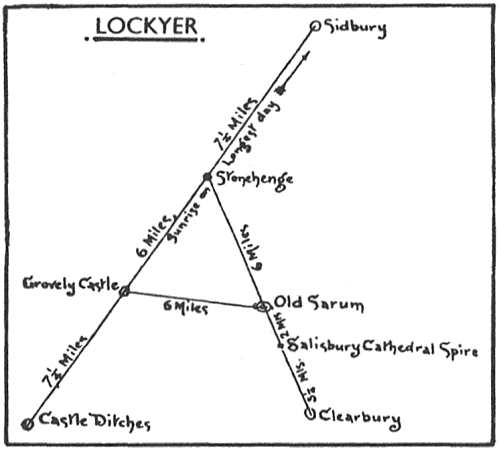
Journal of Geomancy vol. 3 no. 4, July 1979
{105}
I am slowly recovering from the shock that I have seemingly made the discovery of the age! I think I have now discovered the ‘centrepiece’ to the Earth Tableau, and it’s shattering, for it is a colossal human head (male) and all the other effigies fall around in a perfect design. So many puzzles fall into their right place now! I haven’t found all of it, and I think I must give other people the opportunity to have the thrill of helping to put this huge tableau together. The art of these effigies has to be seen to be believed!
Anyone wishing to help Mollie Carey with this project should contact her at Address, Near Warminster, Wiltshire.
In 1972 I had the idea of connecting up all the Wiltshire white horses to see if anything meaningful would become apparent. I also connected the three forts nearest to Stonehenge; Sidbury, Yarnbury and Figsbury. This time something did show. The forts triangle I immediately recognized as belonging to a heptagon of 77° 51° 51°. The same showed up in the white horse configurations, which I eventually dismissed on the grounds that the horses were cut recently. On looking around the maps, I found that Badbury Rings constituted a heptagon triangle 77° 77° 26°. All the measurements were made by protractor. And the centre of each fort was used. Since the forts are so extensive, and it takes something like 200 metres to appreciate any deviation, a large margin of error could be tolerated, though was not necessary. I have now listed quite a few of these triangles, all in the Wessex area (20), and there are more to find. Some of them follow a pattern.
Things did not stop there. I found a mass of interconnecting right angles chaining up to six times and returning to the starting point. And to complicate matters still further a mass of equidistances.
This together with Grovely Castle, an iron age fort of convex triangular plan, and an egg-shaped camp situated near Farnham Wood, form a fairly good equilateral triangle, the sides being of equal length to within 55 metres. Measurements are from site determinable centre to within 25 metres of actual, that is allowing 15 metres for error, on O.S. 1 : 50 000 scale maps. By taking the east rampart of Old Sarum as omphalos or any number of juggling manoeuvres, it would be possible to get a 9·7 km equilateral triangle out of the first-mentioned alignment.
The line from Stonehenge to Grovely also goes to Heredene Wood Castle Ditches, just about 70 metres inside its innermost rampart. At the other end it goes to Sidbury Iron Age fort, just scraping the innermost rampart. A line of this one from Grovely to Bratton White Horse iron age fort is due north, making 49°, which is possibly a Heinsch type alignment.

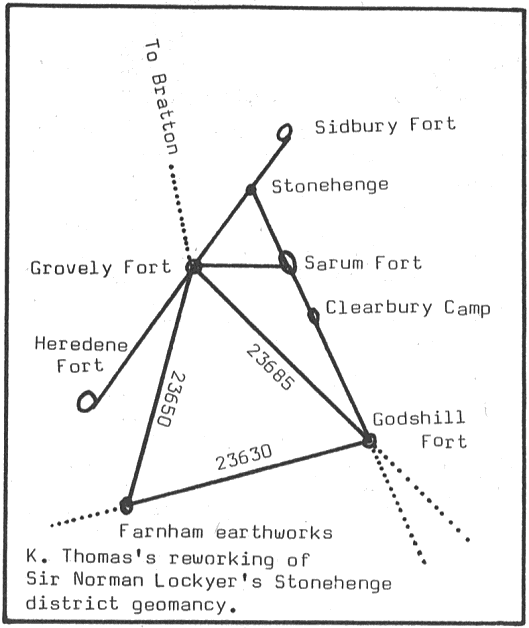
In another geomantic magazine a particular person regurgitated one of Lockyer’s perennial Stonehenge alignments. The one in question was the said perfect equilateral formed by Stonehenge, Grovely Castle and Old Sarum. As you can see from the illustration this triangle is anything but perfect, wanting another 200 metres on the Sarum to Grovely line. If one extends the Lockyer Stonehenge to Clearbury line it reaches Godshill, an Iron Age fort, which is roughly circular in plan.
John Bullock’s Studies on the Arrangement of Sites, IGR Occasional Paper No. 13, is provided free with this issue to IGR members – 45p to non-members. Equilateral triangles, too feature in Mr Bullock’s work.
{106}
Further to Mollie Carey’s intriguing discovery, the subject of her letter in the last JOG, two years ago I found a huge winged bull clearly marked around the South Devon/Dorset border. Axminster lies on the wing and Colyton on the hind legs. Bulmoor Cross is at the top of a foreleg, and Trinity Beacon is at its heart. The eye is at Dragon Hill, near Lyme Regis. Two places of worship once stood on the bull’s snout; a chapel, now vanished and the parish church of St. Michael, replete with dragon carvings. Perhaps it is time for the bull to take off!
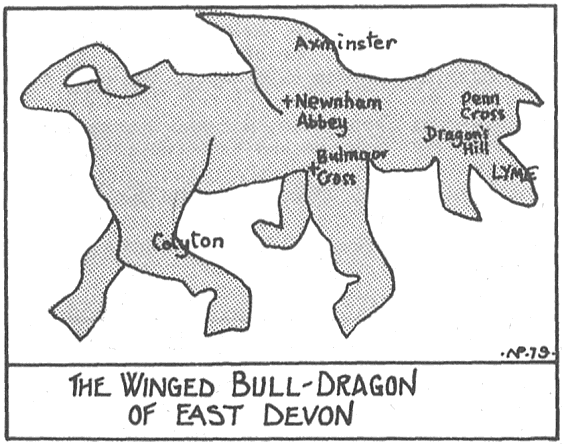
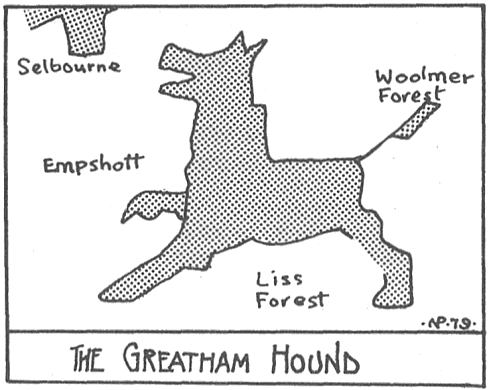
I was pleased to see at Bury and Holderness attempts had at least been made to find some sort of dog (although the outlines of both leave much to be desired!). Doing some work on Alton, I came across the outline for a dog (beyond the Aquarius sector), chasing the Aquarian bird as it soars into the air. “Snap Wood” appears on the nose and would suggest this. Perhaps Michael Behrend would like to take this further. I discovered the lower open jaw of my Shenley/Radlett hound is modern. It looks better and similar to the Ardeley Hound without it anyway: The hind paw has also been altered, and I’ve generally had a good ‘clean up’ and improvement on my effigies where it was needed.
The Old Bolingbroke terrestrial zodiac is situated in Lincolnshire, O.S. maps 122 and 131, approximately 15 miles east of Lincoln city. The figures of the zodiac cover a circular area of approximately 25 miles diameter, centering on an ancient castle at Old Bolingbroke.
The zodiac is built on what appears to be a true North axis, and is an interesting egg-shaped design. The 12 figures which go to make up the zodiac are as follows:
Aries: A ram facing west situated over Wood Halls Park. A tumulus forms an eye and Halstead Wood forms its horn. More recently discovered is a flag that falls across the ram’s shoulder. This is interesting as it is very similar to the emblem of the Templars. {107}
Taurus: A bull, similar to the bull in the Glastonbury Zodiac. He is, however, depicted stabbing at Old Bolingbroke (the centre of the zodiac) with his horn. At the tip of the horn lies a church and the remains of an ancient castle. The castle in its day was of great importance as it was in control of the main water supply for some distance around. Old Bolingbroke is bubbling with springs.
The village of Asgarby, which is sited on the road forming the top half of the bull’s head and horn is another point of interest. Asgard meaning heaven in Norse has certain connections with a zodiac. The hill on which the horn of the bull lies happens to be called Horncastle Hill.
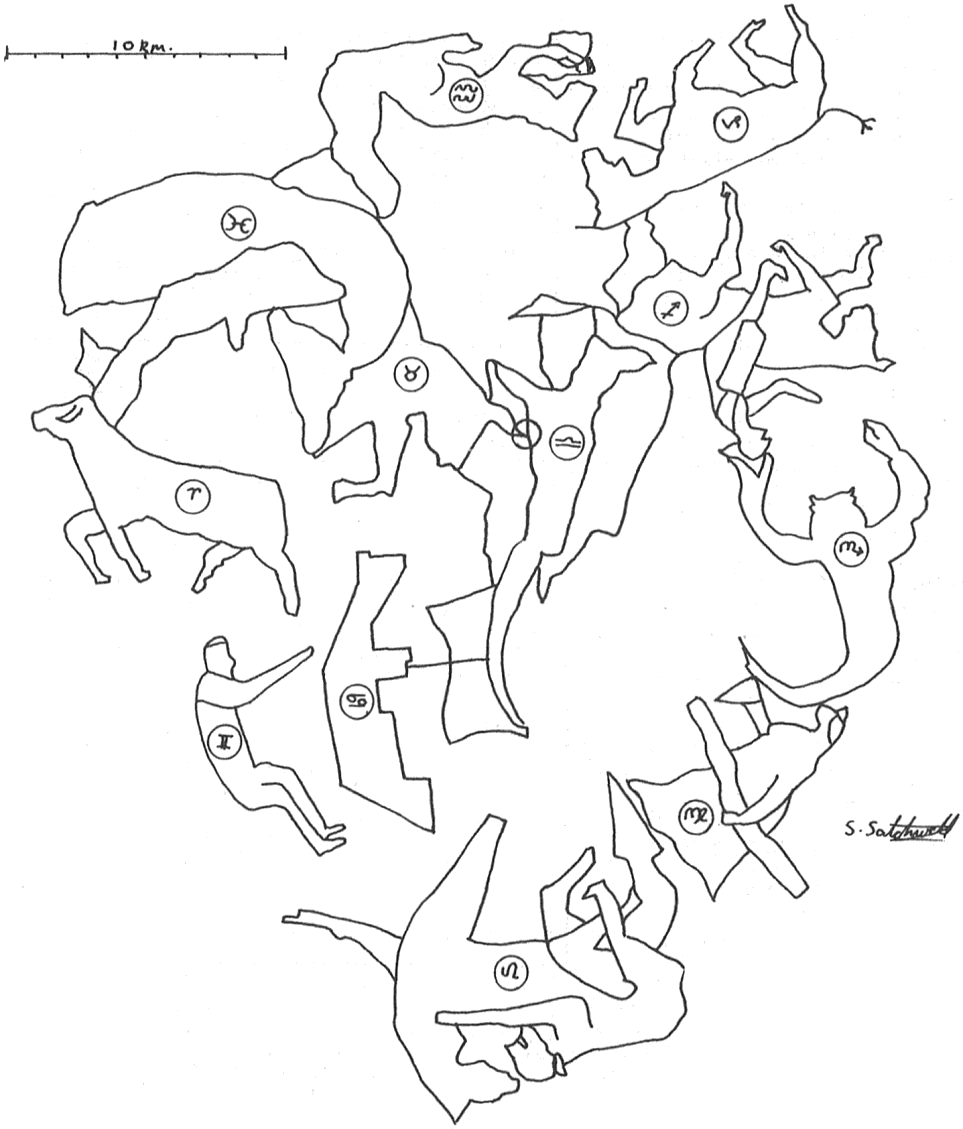
Gemini: A single figure, possibly the giant Orion. There is more to this sign, possibly the second twin, however it is proving difficult to identify.
Cancer: Similar to the Glastonbury Zodiac again, in that the star ship Argo Navis is presented, with the added feature of a raised sail.
Leo: Probably the most interesting sign in the zodiac. Leo is depicted as a figure riding a dragon. The dragon is situated over the town of Boston, and is pointing west, whilst conversing with the rider. This is being indicated by the open mouth of the rider, telling the dragon something, and the exaggerated ear of the rider into which the dragon is speaking. This conversation is backed up by a legend in the Boston area. It tells of how the breezes that blow around the ancient exposed {108} church tower of Boston Stump (sited on the dragon’s throat) were caused by a fight between St. Botolph and the devil. St. Botolph so belaboured Satan that he huffed and puffed, raising the wind, that has not yet died down. The winds mentioned could possibly be a representation of a heated argument between the dragon and its saintly rider in the zodiac.
Other features of this sign are a tumulus forming the dragon’s eye, and a town with the name of Wilberton, sited at the dragon’s head. The name Wilberton is pronounced locally as wiverton, which could be derived from wivern, a dragon-like creature.
Virgo: This sign features a witch, or goddess of fertility, and as in the Glastonbury zodiac, she holds a sacred cone. In her left hand, she holds another instrument, as yet unidentified (any suggestions welcome). This second object appears to be being brought into contact with the cone.
Another point of interest is that she appears to be dressed in a cloak-like ceremonial costume with a peaked hat.This may have possible connexions with the renowned witch’s hat.
Libra: This sign is somewhat unusually depicted as a phoenix, being viewed side-on and in a hovering position. It appears to be watching over the battle between the next two figures, Scorpio and Sagittarius.
Scorpio: A scorpion attacking Sagittarius. In its left claw he holds the rider of the horse by the head, and appears to be about to strike the rider with either his sting or the right claw. There is a tumulus with a moat in the tip of the right claw, which seems to be of some significance.There are a large number of ancient sites, such as tumuli, which actually happen to fall upon the lines making up the scorpion. This feature is very prominent and consistent throughout many of the signs in the zodiac
Sagittarius: Represented in the zodiac as a horse and rider, with the horse in gallop. The rider clutches a shield in his left hand and holds the right hand out as if to hold a spear, although, it seems more likely to be the reins of the horse. He may also be wearing a peaked hat, similar to that which Virgo wears. An interesting point of detail to the horse is that it is bridled and saddled ( not shown on drawing).
Capricorn: A unicorn facing west. Again it has a tumulus representing an eye. The unicorn itself appears to be a creature something like a cross between a bull and a horse.
Aquarius: A squirrel is depicted in this sign. Although this is unusual, a squirrel is also Aquarius in the Pumpsaint/Ffarmers terrestrial zodiac in Carmarthenshire. The squirrel has a nut in its paws, and a long barrow forms the squirrel’s nose.
Pisces: The last of the signs features a whale and a dolphin swimming around each other. Again, the whale appears to have the remains of a tumulus which forms an eye. The dolphin has lines radiating out across the head in a similar fashion in which other ancient relics of dolphins have.
This then completes the Old Bolingbroke terrestrial zodiac. There are more external figures to the zodiac, including a short procession of figures. However, these require more work at the moment. I would like to give credit to Vince Russett (editor of Picwinnard, the magazine of Wessex leys and folklore) for his help and contributions to this zodiac.